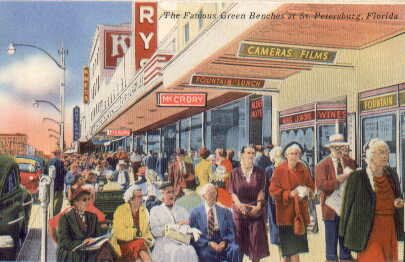
Pre-Air History of WTVT

St. Petersburg in the late 40's. A great place to relax and enjoy the sunshine.
Sit on one of the green benches along Central Avenue.
Slip into McCrory's for a soda.
Listen to WTSP or WSUN radio. But don't buy that TV just yet...
The Tampa Bay area's status as a retirement haven began to change in the early 1950's as more families took up permanent residence to enjoy the year-round higher temperatures, nearby recreation on sunny beaches, and a growing consumer economy.The expanding population with their greater spending power made Tampa Bay a natural market for television.*
This chart was issued by the St. Pete Chamber of Commerce
to show the area's amazing post-war growth.
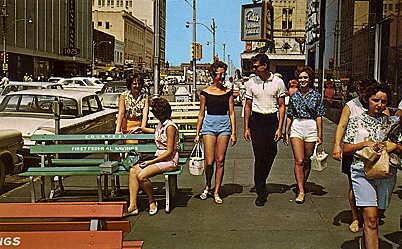
The green benches soon would be gone, but these younger types won't miss them.
When they're not skiing, swimming,or playing golf,
they're watching Channel 13!
Television did not arrive in Tampa Bay until 1953. WSUN-TV, Channel 38, signed on Memorial Day weekend and it took another two years for Channel 8 and 13 to begin broadcasting. Who was responsible for the delay? Why, the federal government, of course!
In the late 1940's, The Federal Communications Commission (FCC) was overwhelmed with applications for television licenses. With Channel 1 reserved for the military, only VHF (Very High Frequency) channels 2 through 13 were allocated for commercial use, and the government saw a logjam of applicants in the making. There was also concern that VHF station signals would intrude into other markets.
In 1948, all applications for VHF television licenses were frozen by the FCC in order to evaluate the spectrum and set guidelines for awarding licenses around the country. By adding UHF (Ultra High Frequency) channels 14 through 83 to the mix, the problem of allocation was eased and the FCC freeze was lifted in 1952. The new spectrum allowed room for 617 VHF, 1436 UHF, and 242 educational/non-commercial licenses.
In the early days of television broadcasting, CBS, NBC, ABC, and Dumont were not supplying enough programming to fill an entire day. Hoping that local stations non-network programming would be used for news, education, or programs in the public interest, the FCC was very interested in learning what the license applicants were planning to do with the time allocated for local schedules.
The FCC's guidelines for awarding licenses also called for diversification, as explained in this press release:
"In a long line of cases we have established the principle that diversification of the media of mass communication is desirable, and that in the absence of countervailing considerations, a grant to an applicant with fewer broadcast interests or who is not associated with other radio or newspaper interests better serves the public interest."
There was, however, a 'Catch 22' to this logic.
Businessmen interested in starting a television station would need to secure an enormous amount of capital. Studios, cameras, transmitters, and staff would mean an initial investment in the hundreds of thousands of dollars.Despite the FCC's wish for diversification, newspaper chains were among the first to be able to finance television operations. Lacking suitable competitors for a license, the FCC would often grant a franchise to newspapers that already owned local radio stations. In 1953, 69% of ALL television stations were owned by newspapers. The positive side of this situation is that some local stations carried on a journalistic tradition inherited from their newspaper management.
...LIVE, FROM THE MILLION DOLLAR PIER...
"Mr. Sun" served as the city's mascot and
as WSUN's I.D.
The FCC decided to make Tampa Bay's first television license Channel 38, a UHF frequency. It was an unfortunate decision in the sense that few existing TVs at the time were capable of UHF reception, and new sets would require the UHF tuner at extra expense. This situation made it harder for the owner of Channel 38 to compete with VHF outlets that would later appear in the Tampa Bay area, and there must have been some realization of that fact because only two applicants lined up to apply for the license...an out of state corporation and locally owned WSUN radio.
WSUN radio was unique in that it was owned and operated by the City of St. Petersburg. The city's success with WSUN radio was listed on their FCC license application as a significant reason for receiving a television license. When the other applicant for Channel 38's license dropped out of consideration, the City of St. Petersburg was awarded the license.
WSUN studios were located on the ground floor of the famous 'Million Dollar Pier' on St. Pete's bayfront. Being the area's only TV station, WSUN had a monopoly on local viewers, and enjoyed the rare privilege of cherry picking programming from CBS, NBC, ABC, and Dumont. Prior to the arrival ofthe television coaxial cable in the spring of 1954, WSUN's network programming made use of 16mm film and kinescopes. The coax cable set up by Peninsular Telephone terminated in Tampa. It was then that Channel 38 became the nation's first station to receive a live feed of the World Series via a microwave from the telephone company in Tampa. The door was now open for WSUN to relay live broadcasts from the east coast. However, WSUN's monopoly on Tampa Bay television viewers was about to come to an end...
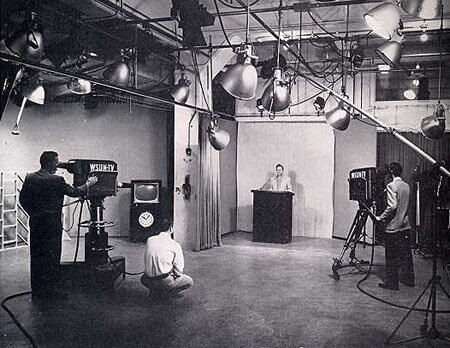
WSUN is on the air! Channel 38's studio was located
on the ground floor of St. Pete's Million Dollar Pier
To learn more about the early days of WSUN, read the story of Bob Gilbert.
Competition!
The second channel allocated to Tampa Bay by the FCC was Channel 8 on the VHF frequency. During the 1954 application process for Channel 8, two newspaper-related companies vied for the lucrative VHF channel: The Tampa Tribune, a daily newspaper, and the Pinellas Broadcasting Company, owned by St. Petersburg Times publisher and President of WTSP radio, Nelson Poynter. Despite an appeal by Poynter, WFLA's license was awarded to the owners of the Tampa Tribune. Affiliation with the NBC network soon followed and construction began on a state-of-the-art facility on Jackson Street in downtown Tampa.
13...A LUCKY NUMBER
The third license in the Tampa Bay market was for Channel 13. Three applicants lined up for consideration in 1954:
The Tampa Television Company
(co-owned by the management of WALT radio, in Tampa)
Orange Television Broadcasting Company
(no media properties)
The Tampa Times, publishers of a daily newspaper
(owners and operators of radio station WDAE)
In August of 1954, The FCC examiner recommended that the license for Channel 13 be awarded to the Tampa Times. Had that occurred, Channel 13 would probably be known as WDAE-TV.
But the decision was overruled and the license was granted to the Tampa Television Company, headed by former Florida Governor Doyle E. Carlton, and Walter F. Tison, founder of WALT radio in Tampa. The decision was based upon a belief that Tampa Television's local programming aspirations were superior to other applicants because of their broadcast experience, and that the FCC commissioners were impressed by Tampa TV's plans for a satellite studio in St. Petersburg. Tison, whose experience with Tampa Bay radio went back to the 1930's, had launched WALT in 1946, and stated that he planned to sell the radio station upon gaining the license for Channel 13.
Walter Tison (1955)
This was quite a disappointment for The Tampa Times, which had already begun studio planning and construction of a transmitter on the belief that they would be awarded the license for Channel 13. A major Times challenge for the license would soon effect Channel 13's debut plans.
Channel 13 would take the remaining network affiliation available in the Tampa Bay market, CBS. This would leave WSUN affiliated with the ABC network.
In September, 1954, Walter Tison told the St. Pete Times that work was beginning immediately on Channel 13, which would be equipped for color when it went on the air...hopefully in time for the annual Gasparilla celebrations in February, 1955.
Meanwhile, The Tampa Times filed an appeal and the license was frozen pending a review process. The appeal dragged on into 1955.
"We were running neck and neck with WFLA,'" said a confident but cautious Tison in January, 1955. "Footings for a television tower are already in, the lands cleared and the buildings are ready. The tower and antenna are standing on the ground, ready to be installed, where they will stay until the FCC reaches a decision on a rehearing asked by the other two contenders for the channel."
Tison is probably referring to the transmitter site in Baum, about 15 miles southeast of Tampa.
Knowing the monumental task of constructing a television studio and transmitting facility, Tison added "Because of the delay, we'd have to resume construction tomorrow to be on the air by the middle of April."
WFLA's transmitter went active on January 29, 1955, with a test pattern for station engineers to make necessary adjustments.
Actual photo off monitor showing WFLA's test pattern
When the Gasparilla celebration occurred on February 14, WFLA was there and made the pirate invasion and parade their broadcast premiere.
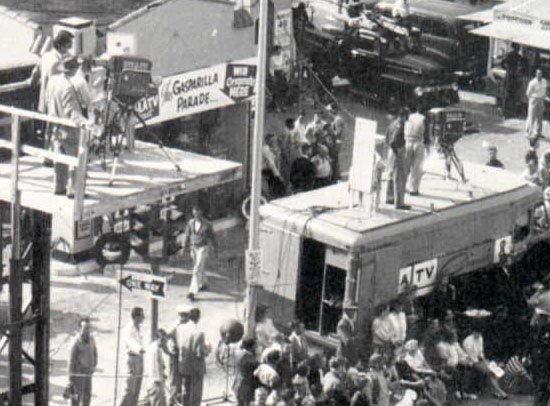
PREMIERE DAY FOR WFLA AT TAMPA'S
GASPARILLA PARADE, FEBRUARY 14, 1955
The same day Channel 8's transmitter started test operations, January 29, the FCC confirmed their decision about Channel 13's license and lifted the freeze on Tampa Television. Tison ordered the transmitter installed and resumed preparation for an April launch. The aborted WDAE television transmitter stood in downtown Tampa well into the 1970's as a painful reminder of the Tampa Time's failure to secure the license. In the meantime, WTVT's transmitter went on line, sending a test pattern to receivers in the Tampa Bay area.
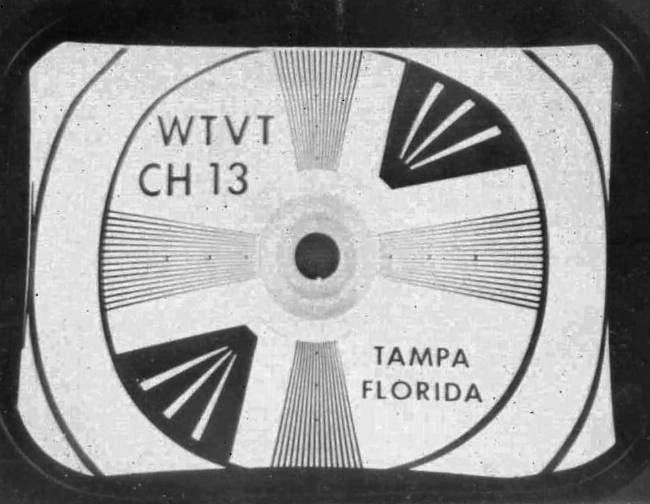
Watch out, Channel 8...Channel 13 is on the way!
Tison named Daniel H. Smith as chief engineer and assistant general manager. Monte Gurwit, formerly of WSUN-TV, was hired as program manager, film buyer, and on-air host. About 35 staffers would be needed to get Channel 13 on the air. Positions to be filled included production, engineering, sales, secretarial, traffic, accounting, and on-air personalities.
WHAT'S IN A NAME?
Starting a TV station is a major endeavor, but there was another challenge for Tison's group...they needed a four-letter word. A name for the station.
Call letters are one of the most important branding tools for a station. Great call letters that signify strength, reflect the community or its ownership, or just plain sound cool when spoken are a tremendous asset in promotion. Call letters were sometimes acronyms. WSUN stood for "Why Stay Up North?" WDAE meant "Wonderful Days and Evenings." Channel 8 had "WFLA."
So how did Channel 13 gain the snappy call letters 'WTVT'?
When a newly licensed channel is added to a television market, it is customary for the applicants to apply to the FCC for call letters. Usually, the applicant will submit several arrangements of call letters for consideration. Blessing the new Channel 13 with the proper call letters was very important to Walter Tison and his managers. But one letter, the first "W," was already mandated by the FCC.
East of the Mississippi river, all stations call letters begin with a "W." West of the Mississippi, all stations call letters begin with a "K."
What would you name a new station in Tampa, knowing that the first letter would have to be a "W"?
Well, the next most likely letters would be "TV," short for TeleVision...and of course a "T" for Tampa, and voila:WTVT!
If you think that's how Channel 13 got their call letters, you'd be dead wrong!
Ron Harpe, a former Tison employee and later Chief Announcer at WTVT, tells a different story. Ron said that:
The "WT" part stands for "Walter Tison."
The "VT" part stands for his wife, "Virginia Tison."
Walter Tison Virgina Tison = WTVT!
WTVT is probably the most graceful set of call letters in the entire country, and very pleasing to the ear. Another bonus was later evident on WTVT's tower.
|
View heading west on Grand Central (Kennedy) Blvd. |
|
Visible by day and illuminated from within at night , the station's call letters read correctly whether drivers were heading east or west on Grand Central Blvd.!
APRIL 1st - NO FOOLING!
Meanwhile, the clock was ticking and Tampa Television was struggling to pull all the elements together to get Channel 13 on the air. The FCC license delay meant that construction of a new, customized television facility, as accomplished by WFLA, would not be possible.
In the early days of television, studios were often housed in department stores, newspaper offices, warehouses, and even former car dealerships. Channel 13's first director, Walter Rhoads**, remembered the search for studio space. "We were in a hurry to get on the air, so we looked for an existing building to get started in."
Channel 13 found a home...at a building originally
built for a Greek restaurant. 'TV Dinner' anyone?
"We found a new Greek restaurant which was to be opened until the owner died, and we decided on that. Engineers came first. Most production people came in March, 1955, two weeks before we went on the air. The kitchen became master control, the dining room became our only studio, the production office was the bar/lounge, and the package store became the sales office, which some people considered appropriate."
The race to get on the air climaxed April 1, 1955...the day Tampa Bay's newest television station, WTVT, Channel 13, went on the air.
*Radio had served the Tampa Bay area since the 1920's. WFLA and WSUN radio (AM 62) shared operations until 1941. Walter Tison, who was awarded the license for Channel 13, was in management for WFLA and WSUN. Other early stations include WDAE, owned by David Smiley, publisher of the Tampa Times. WTSP was owned by Nelson Poynter, publisher of the St. Pete Times. WTSP studios were located in the Times' downtown St. Pete building. In the mid 50's, one of WTSP's on-air personalities was a young, up and coming broadcaster named Paul Reynolds. Reynolds would later become a mainstay at WTVT.
WTSP's frequency was AM 1380. A broadcasting group managed by the Rahall family (Sam, Joe, and Farris) purchased WTSP in 1956. After failing to make the station a commercial success, WTSP followed WALT's format and changed to rock 'n roll. Studios were located on Gandy Blvd. and in 1959, the call letters were changed to WLCY. In 1962, the Rahall family was granted an FCC license for Channel 10. Due to various legal challenges, Channel 10 did not go on the air until 1965. Its call letters were WLCY-TV, and the station took over ABC network affiliation from WSUN. The City of St. Petersburg immediately sold WSUN to a Detroit broadcasting group. After limping along as an independent, WSUN went off the air in 1970.
One other observation about Channel 13. Most CBS and NBC owned and operated and affiliate stations of the time occupied lower channel allocations. CBS in New York, Los Angeles, and Chicago was on Channel 2. NBC in New York and Los Angeles was on Channel 4, with Chicago on Channel 5. Many other markets had CBS and NBC no higher than Ch. 6 on the dial. The FCC's decision to allocate Channels 38, 8, and 13 to Tampa Bay dictated the higher channel for the network affiliates. To this day, you'll find that it's unusual to see a CBS or NBC affiliate in the higher channel range such as Channel 13. (Ft. Myer's WINK, Channel 11 was also an early CBS affiliate located higher up on the dial). To counter-act the superstitious aspect of the number 13, WTVT's promotion department originally tagged the station "Lucky 13."
**Walter Rhoads later became Channel 13's promotion manager, and coined the term we use as the name of our web site...BIG 13.